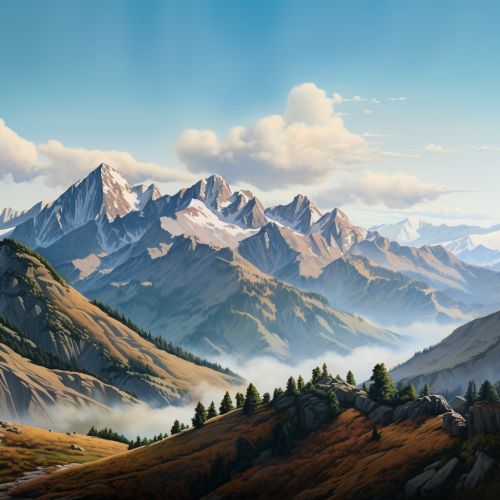Orogeny
Introduction
Orogeny is a geological process that involves the structural deformation of the Earth's lithosphere due to tectonic forces. This process often results in the formation of long, linear mountain ranges. Orogeny, derived from the Greek words for "mountain" and "origin", is a fundamental concept in the field of geology and has been instrumental in understanding the dynamic nature of the Earth's crust.


Geological Processes Involved in Orogeny
Orogeny is a complex process that involves several geological phenomena. These include plate tectonics, seismic activity, metamorphism, and erosion.
Plate Tectonics
Plate tectonics is the primary driver of orogeny. The Earth's lithosphere is divided into several large and small tectonic plates, which are constantly moving due to the convective currents in the underlying asthenosphere. When these plates collide, the compressional forces often result in the formation of mountain ranges, a process known as orogeny.
Seismic Activity
Seismic activity, or earthquakes, are a common occurrence during orogenic processes. The immense tectonic forces involved in plate collisions often cause the lithosphere to crack and fracture, resulting in seismic activity. These earthquakes can provide valuable insights into the ongoing orogenic processes and the structural integrity of the newly formed mountain ranges.
Metamorphism
Metamorphism is another critical aspect of orogeny. The intense heat and pressure generated during the collision of tectonic plates can transform the existing rocks into new metamorphic rocks. This process can significantly alter the mineralogical and textural characteristics of the rocks involved in orogeny.
Erosion
Erosion plays a dual role in orogeny. While it can wear down existing mountain ranges, it can also contribute to the uplift of new ones by removing overlying material and reducing the pressure on the underlying rocks. This process, known as isostasy, is a key factor in the formation and evolution of mountain ranges.
Types of Orogeny
There are several types of orogeny, each characterized by distinct tectonic settings and geological processes. These include Cordilleran orogeny, Alpine orogeny, Himalayan orogeny, and Andean orogeny.
Cordilleran Orogeny
Cordilleran orogeny refers to the mountain-building processes that have shaped the North American Cordillera, a vast mountainous region extending from Alaska to Mexico. This type of orogeny is characterized by subduction, where an oceanic plate sinks beneath a continental plate, leading to the formation of volcanic arcs and mountain ranges.
Alpine Orogeny
Alpine orogeny pertains to the formation of the Alps, a major mountain range in Europe. This process is associated with the collision of the African and Eurasian plates, resulting in the uplift of the Alps. Alpine orogeny is notable for its complex tectonic interactions and the extensive metamorphism of rocks.
Himalayan Orogeny
Himalayan orogeny is responsible for the formation of the Himalayas, the highest mountain range in the world. This process began around 50 million years ago when the Indian plate collided with the Eurasian plate. The ongoing collision continues to uplift the Himalayas, making them a prime example of active orogeny.
Andean Orogeny
Andean orogeny refers to the processes that have formed the Andes, the longest continental mountain range in the world. This type of orogeny is associated with the subduction of the Nazca plate beneath the South American plate, resulting in the uplift of the Andes and the formation of a volcanic arc along the western edge of South America.
Implications of Orogeny
Orogeny has profound implications for various aspects of Earth's systems, including climate, biodiversity, and human civilization.
Climate
Mountain ranges formed through orogeny can significantly influence regional and global climate patterns. They can act as barriers to atmospheric circulation, causing changes in temperature and precipitation patterns. For example, the Himalayas have a profound impact on the climate of the Indian subcontinent by blocking cold winds from the north and influencing the monsoon patterns.
Biodiversity
Orogeny can also impact biodiversity by creating new habitats and geographical barriers. The uplift of mountain ranges can lead to the isolation of species and promote speciation, contributing to biodiversity. For instance, the Andes are one of the most biodiverse regions in the world, hosting numerous endemic species that have adapted to the unique conditions of the high-altitude environment.
Human Civilization
Orogeny has played a crucial role in shaping human civilization. Mountain ranges have served as natural barriers, influencing the migration and settlement patterns of human populations. They have also been a source of valuable resources, such as minerals, timber, and water, which have been instrumental in the development of societies.
